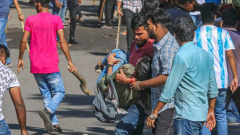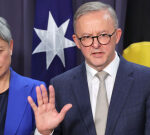Dhaka, Bangladesh – Sinthia Mehrin Sokal remembers the blow to her head on July 15 last year when she, along with thousands of fellow students, marched during a protest against a controversial quota system in government jobs in Bangladesh’s capital, Dhaka.
The attack by an activist belonging to the student wing of the then-Prime Minister Sheikh Hasina’s Awami League party left Sokal – a final-year student of criminology at the University of Dhaka – with 10 stitches and temporary memory loss.
A day later, Abu Sayed, another 23-year-old student, was protesting at Begum Rokeya University in the Rangpur district, about 300km (186 miles) north of Dhaka, when he was shot by the police. A video of him, with his arms outstretched and collapsing on the ground moments later, went viral, igniting an unprecedented movement against Hasina, who governed the country with an iron fist for more than 15 years before she was toppled last August.
Students from schools, colleges, universities and madrassas took to the streets, defying a brutal crackdown. Soon, the young protesters were joined by their parents, teachers and other citizens. Opposition parties, including the Bangladesh Nationalist Party (BNP) and the Bangladesh Jamaat-e-Islami, lent crucial support, forming an unlikely united front against Hasina’s government.
“Even students in remote areas came out in support. It felt like real change was coming,” Sokal told Al Jazeera.
On August 5, 2024, as tens of thousands of protesters stormed Hasina’s palatial residence and offices in Dhaka, the 77-year-old leader boarded a military helicopter and fled to neighbouring India, her main ally, where she continues to defy a Bangladesh court’s orders to face trial for crimes against humanity and other charges.

By the time Hasina fled, more than 1,400 people had been killed, most when government forces fired on protesters, and thousands of others were wounded, according to the United Nations.
Three days after Hasina fled, the protesters installed an interim government, on August 8, 2024, led by the country’s only Nobel laureate, Muhammad Yunus. In May this year, the interim government banned the Awami League from any political activity until trials over last year’s killings of the protesters concluded. The party’s student wing, the Chhatra League, was banned under anti-terrorism laws in October 2024.
Yet, as Bangladesh marks the first anniversary of the end of Hasina’s government on Tuesday, Sokal said the sense of unity and hope that defined the 2024 uprising has given way to disillusionment and despair.
“They’re selling the revolution,” she said, referring to the various political groups now jostling for power ahead of general elections expected next year.
“The change we fought for remains out of reach,” said added. “The [interim] government no longer owns the uprising.”

‘What was my son’s sacrifice for?’
Yunus, the 85-year-old Nobel Peace Prize winner presiding over Bangladesh’s democratic overhaul, faces mounting political pressure, even as his interim government seeks consensus on drafting a new constitution. Rival factions that marched shoulder to shoulder during anti-Hasina protests are now locked in political battles over the way forward for Bangladesh.
On Tuesday, Yunus is expected to unveil a so-called July Proclamation, a document to mark the anniversary of Hasina’s ouster, which will outline the key reforms that his administration argues Bangladesh needs – and a roadmap to achieve that.
But not many are hopeful.
“Our children took to the streets for a just, democratic and sovereign Bangladesh. But that’s not what we’re getting,” said Sanjida Khan Deepti, whose 17-year-old son Anas was shot dead by the police during a peaceful march near Dhaka’s Chankharpul area on August 5, 2024. Witnesses said Anas was unarmed and running for cover when a police bullet struck him in the back. He died on the spot, still clutching a national flag.
“The reforms and justice for the July killings that we had hoped – it’s not duly happening,” the 36-year-old mother told Al Jazeera. “We took to the streets for a better, peaceful and just country. If that doesn’t happen, then what was my son’s sacrifice for?”
Others, however, continue to hold firm in their trust in the interim government.
“No regrets,” said Khokon Chandra Barman, who lost almost his entire face after he was shot by the police in the Narayanganj district.
“I am proud that my sacrifice helped bring down a regime built on discrimination,” he told Al Jazeera.
Barman feels the country is in better hands now under the Yunus-led interim government. “The old evils won’t disappear overnight. But we are hopeful.”

Atikul Gazi agreed. “Yunus sir is capable and trying his best,” Gazi told Al Jazeera on Sunday. “If the political parties fully cooperated with him, things would be even better.”
The 21-year-old TikToker from Dhaka’s Uttara area survived being shot at point-blank range on August 5, 2024, but lost his left arm.
A selfie video of him smiling, despite missing an arm, posted on September 16 last year, went viral, making him a symbol of resilience.
“I’m not afraid… I’m back in the field. One hand may be gone, but my life is ready to be offered anew.”

‘Instability could increase’
Others are less optimistic. “That was a moment of unprecedented unity,” said Mohammad Golam Rabbani, a professor of history at Jahangirnagar University on the outskirts of Dhaka.
Rabbani had recited a poem during a campus protest on July 29, 2024. Speaking at an event last month to commemorate the uprising, he said: “Safeguarding that unity should have been the new government’s first task. But they let it slip.”
The coalition of students, professionals and activists, called Students Against Discrimination, that brought down Hasina’s government, began to fragment even before Yunus took charge.
Hoping to cash in on massive anti-Awami League sentiment, the main opposition BNP has been demanding immediate elections since the uprising. But parties like the National Citizens Party, formed by student leaders of the 2024 protests, and Bangladesh Jamaat-e-Islami want deeper structural reforms before any vote is held.
To reconcile such demands, the Yunus administration formed a National Consensus Commission on February 12 this year. Its mandate is to merge multiple reform agendas outlined by expert panels into a single political blueprint. Any party or coalition that wins the next general election must formally pledge to implement this charter.
But so far, the meetings of the commission have been marked by rifts and dissent, mainly over having a bicameral parliament, adopting proportional representati





